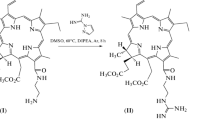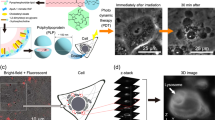Abstract
In this report, we describe an effect of photodynamic therapy (PDT) on membrane trafficking in murine 1c1c7 hepatoma cells. A brief exposure of 1c1c7 cells to a 20 nM concentration of the phosphatidylinositol kinase class-3 antagonist wortmannin led to the rapid appearance of cytoplasmic vacuoles. Fluorescence monitoring of plasma membrane-associated 1-[4-(trimethylamino)- phenyl]-6-phenylhexa-1,3,5-triene (TDPH) over time demonstrated that the wortmannin-induced vacuoles were derived from endocytosed plasma membrane. Low-dose photodamage catalyzed by the lysosomal photosensitizer NPe6, prior to the addition of wortmannin, prevented formation of these vacuoles. NPe6 was found to suppress for several hours the normal trafficking of TDPH-labeled plasma membrane to the cytosol, and the formation of punctate TDPH-labeled cytoplasmic vesicles. The ability of NPe6-induced photodamage to suppress wortmannin-induced vacuolization occurred under conditions that did not disrupt lysosomes and were at or below the threshold of cytostatic/cytotoxic effects. Furthermore, the suppressive effects of NPe6-PDT were not prevented by inclusion of an agent that stabilized lysosomal membranes, or by E64d, an inhibitor of lysosomal cathepsin proteases. Mitochondrial photodamage was less effective at preventing wortmannin-induced vacuole formation and PDT directed against the ER had no effect. The role of photodamage to the endocytic pathway may be a hitherto unexplored effect on cells that selectively accumulate photosensitizing agents. These results indicate that photodamage directed against endosomes/lysosomes has effects independent of the release of lysosomal proteases. aDepartment of Pharmacology,Wayne State University School of Medicine, Detroit, MI, 48201, USA bCancer Biology Program, Wayne State University, Detroit, MI, 48201, USA cInstitute of Environmental Health Sciences, Eugene Applebaum Building, Wayne State University, Detroit, MI, 48201, USA Abbreviations BPD Benzoporphyrin derivative E64d 2S,3S-trans-(ethoxycarbonyloxirane-2-carbonyl)- L-leucine-(3-methylbutyl) amide (an inhibitor of calpain and cysteine protease activity) ER Endoplasmic reticulum LDxx PDT dose that reduces viability to xx% of controls LMP Lysosomal membrane permeabilization LSG LysoSensor Green mTHPC meso-Tetrahydroxyphenylporphine NPe6 N-Aspartyl chlorine e63-O-MeSM 3-O-Methyl sphingomyelin PCI Photochemical internalization PDT Photodynamic therapy PI Phosphatidyl inositol TDPH 1-[4-(Trimethylamino)phenyl]-6-phenylhexa-1,3,5- Triene
Similar content being viewed by others
Abbreviations
- BPD:
-
Benzoporphyrin derivative
- E64d:
-
2S,3S-trans-(ethoxycarbonyloxirane-2-carbonyl)-l-leucine-(3-methylbutyl) amide (an inhibitor ofcalpain and cysteine protease activity)
- ER:
-
Endoplasmic reticulum
- LDxx:
-
PDT dose that reduces viability to xx% of controls
- LMP:
-
Lysosomal membrane permeabilization
- LSG:
-
LysoSensor Green
- mTHPC:
-
meso-Tetrahydroxyphenylporphine
- NPe6:
-
N-Aspartyl chlorine e6
- 3-O-MeSM:
-
3-O-Methyl sphingomyelin
- PCI:
-
Photochemical internalization
- PDT:
-
Photodynamic therapy
- PI:
-
Phosphatidyl inositol
- TDPH:
-
1-[4-(Trimethylamino)phenyl]-6-phenylhexa-1,3,5-triene
References
T. J. Dougherty, C. J. Gomer, B. W. Henderson, G. Jori, D. Kessel, M. Korbelik, J. Moan and Q. Peng, Photodynamic therapy, J. Natl. Cancer Inst., 1998, 90, 889–905.
J. J. Reiners Jr, P. Agostinis, K. Berg, N. L. Oleinick and D. Kessel, Assessing autophagy in the context of photodynamic therapy, Autophagy, 2010, 6, 7–18.
N. L. Oleinick, R. L. Morris and I. Belichenko, The role of apoptosis in response to photodynamic therapy: what, where, why, and how, Photochem. Photobiol. Sci., 2002, 1, 1–21.
R. Kjeken, S. A. Mousavi, A. Brech, G. Griffiths and T. Berg, Wortmannin-sensitive trafficking steps in the endocytic pathway in rat liver endothelial cells, Biochem. J., 2001, 357(2), 497–503.
B. J. Reaves, N. A. Bright, B. M. Mullock and J. P. Luzio, The effect of wortmannin on the localisation of lysosomal type I integral membrane glycoproteins suggests a role for phosphoinositide 3-kinase activity in regulating membrane traffic late in the endocytic pathway, J. Cell. Sci., 1996, 109, 749–762.
H. Shpetner, M. Joly, D. Hartley and S. Corvera, Potential sites of PI-3 kinase function in the endocytic pathway revealed by the PI-3 kinase inhibitor, wortmannin, J. Cell Biol., 1996, 132, 595–605.
N. A. Bright, M. R. Lindsay, A. Stewart and J. P. Luzio, The relationship between lumenal and limiting membranes in swollen late endocytic compartments formed after wortmannin treatment or sucrose accumulation, Traffic, 2001, 2, 631–642.
F. Scarlatti, R. Maffei, I. Beau, R. Ghidoni and P. Cagodno, Noncanonical autophagy: an exception or an underestimated form of autophagy?, Autophagy, 2008, 4, 1083–1085.
D. Kessel, M. G. Vicente and J. J. Reiners Jr, Initiation of apoptosis and autophagy by photodynamic therapy, Lasers Surg.Med., 2006, 38, 482–488.
G. Ouédraogo, P. Morlière, C. Mazière, J. C. Mazière and R. Santus, Alteration of the endocytotic pathway by photosensitization with fluoroquinolones, Photochem. Photobiol., 2000, 72, 458–463.
G. Ouédraogo, P. Morlière, M. Bazin, R. Santus, B. Kratzer, M. A. Miranda and J. V. Castell, Lysosomes are sites of fluoroquinolone photosensitization in human skin fibroblasts: a microspectro-fluorometric approach, Photochem. Photobiol., 1999, 70, 123–129.
F. G. Prendergast, R. P. Haugland and P. J. Callahan, 1-[4- (Trimethylamino)phenyl]-6-phenylhexa-1,3,5-triene: synthesis, fluorescence properties and use as a fluorescent probe of lipid bilayers, Biochemistry, 1981, 20, 7333–7338.
D. Illinger and J. G. Kuhry, The kinetic aspects of intracellular fluorescence labeling with TMA-DPH support the maturation model for endocytosis in L929 cells, J. Cell Biol., 1994, 125, 783–794.
P. J. Lou, P. S. Lai, M. J. Shieh, A. J. Macrobert, K. Berg and S. G. Bown, Reversal of doxorubicin resistance in breast cancer cells by photochemical internalization, Int. J. Cancer, 2006, 119, 2692–2698.
O. J. Norum, P. K. Selbo, A. Weyergang, K. E. Giercksky and K. Berg, Photochemical internalization (PCI) in cancer therapy: from bench towards bedside medicine, J. Photochem. Photobiol., B, 2009, 96, 83–92.
L. Prasmickaite, A. Høgset, P. K. Selbo, B. Ϙ. Engesaeter, M. Hellum and K. Berg, Photochemical disruption of endocytic vesicles before delivery of drugs: a new strategy for cancer therapy, Br. J. Cancer, 2002, 86, 652–657.
P. R. Twentyman and M. Luscombe, A study of some variables in a tetrazolium dye (MTT) based assay for cell growth and chemosensitivity, Br. J. Cancer, 1987, 56, 279–285.
J. J. Reiners Jr., J. A. Caruso, P. A. Mathieu, B. Chelladurai, X. H. Yin and D. Kessel, Release of cytochrome c and activation of pro-caspase-9 following lysosomal photodamage involves Bid cleavage, Cell Death Differ., 2002, 9, 934–944.
J. A. Caruso, P. A. Mathieu and J. J. Reiners Jr., Sphingomyelins suppress the targeted disruption of lysosomes/endosomes by the photosensitizer NPe6 during photodynamic therapy, Biochem. J., 2005, 392, 325–334.
T. I. Peng, C. J. Chang, M. J. Guo, Y. H. Wang, J. S. Yu, H.Y. Wu and M. J. Jou, Mitochondrion-targeted photosensitizer enhances the photodynamic effect-induced mitochondrial dysfunction and apoptosis, Ann. N. Y. Acad. Sci., 2005, 1042, 419–428.
M. H. Teiten, L. Bezdetnaya, P. Morlière, R. Santus and F. Guillemin, Endoplasmic reticulum and Golgi apparatus are the preferential sites of Foscan localisation in cultured tumour cells, Br. J. Cancer, 2003, 88, 146–152.
D. Kessel, Effects of PDT on the endocytic pathway, Proc. SPIE, 2010, 7551, 1–7.
X. Chen and Z. Wang, Regulation of intracellular trafficking of the EGF receptor by Rab5 in the absence of phosphatidylinositol 3-kinase activity, EMBO Rep., 2001, 2, 68–74.
Author information
Authors and Affiliations
Rights and permissions
About this article
Cite this article
Kessel, D., Price, M., Caruso, J. et al. Effects of photodynamic therapy on the endocytic pathway. Photochem Photobiol Sci 10, 491–498 (2011). https://doi.org/10.1039/c0pp00276c
Received:
Accepted:
Published:
Issue Date:
DOI: https://doi.org/10.1039/c0pp00276c




